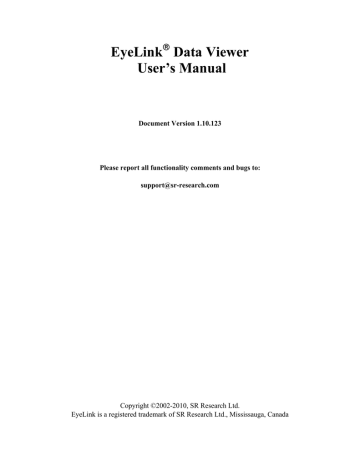
advertisement

The Interest Area Output Report generates one row for each interest area in every trial loaded in the Data Viewer. Variables include the interest area identifier, label, fixation index list, number fixations, summed dwell time, and proportions of fixations and dwell time in the interest area relative to the trial.
The Trial Output Report generates one row of data for each trial within the Data Viewer.
Variables include the count of each event type visible within the trial, the average fixation duration and saccadic amplitude, as well as the reaction time calculated for the trial based on the reaction time definitions created for the Data Viewer session.
The Sample Output Report provides a columnar output of eye movement data for each eye sample in a trial. Variables include the index of the sample in a trial, time of the sample, position (x, y), velocity, acceleration, and pupil data of the current sample. If appropriate target position messages are read from the EDF file, the position, velocity, and acceleration data of the targets (up to two targets) can also be provided.
The user can also save the spatial overlay and temporal graph views into image files, save the playback of the trial into a movie file, or create a "landscape" view (i.e., fixation map) for a trial or for a group of trials with the same background image.
1.7 Experiment Integration
The EyeLink Data Viewer allows commands to be inserted directly into the EyeLink
EDF file when an experiment is running. This allows the experiment to be significantly integrated into the Data Viewer. These commands are interpreted by the Data Viewer when the data file is loaded and automates several areas of the viewer functionality.
By using a set of predefined viewer commands, the programmer of an experiment can inform the Data Viewer regarding: a) The image(s) to load for each trial’s Spatial Overlay View. b) The Interest Areas to load for each trial. c) The Reaction Time Definitions to apply to the Data Viewing session. d) The trial condition variables and values to use for each trial. e) The position of the target in a dynamic display.
EyeLink Data Viewer
©2002-2010 SR Research Ltd.
4
advertisement
* Your assessment is very important for improving the workof artificial intelligence, which forms the content of this project
Related manuals
advertisement
Table of contents
- 8 Introduction
- 8 Data Visualization
- 9 Event Selection
- 9 Interest Area Definition
- 9 Event Filtering
- 10 Interest Periods and Reaction Time Definition
- 10 Data Output and Analysis
- 11 Experiment Integration
- 12 Installation
- 12 System Requirements
- 12 Setup
- 12 For Standard Installation (applicable to most users)
- 13 For Installation using Network Licensing
- 14 Working with Files
- 14 Creating a Data Viewing Session (DVS)
- 14 Saving a Viewing Session
- 14 Opening an Existing Viewing Session
- 15 Saving an Existing Viewing Session to a Different File
- 15 Importing an EyeLink Data File
- 17 Data Viewer Windows
- 17 Inspector Window
- 17 Data Tab
- 19 Data Tree Hierarchy
- 19 Trial Grouping
- 20 Trial Summary
- 21 Interest Area Templates
- 22 Custom Interest Area Set/Empty Interest Area Set
- 22 Preferences Tab
- 22 Trial View Window
- 22 Selecting Data Elements to Display
- 23 Cloning a Trial View
- 23 Tiling/Cascading Windows
- 24 Spatial Overlay Trial View
- 26 Temporal Graph Trial View
- 26 Viewing Sample and Target Data
- 28 Zooming Operations
- 28 Animation View
- 31 Working with Events, Samples, and Interest Areas
- 31 Common Operations
- 32 Selecting Events
- 32 Deleting Events
- 32 Fixations
- 35 Selecting Fixations
- 35 Merging Fixations
- 35 Drift Correcting Fixations